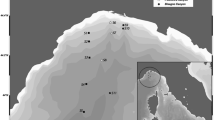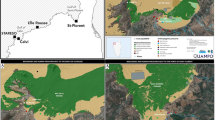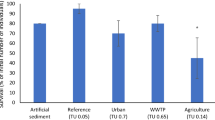Abstract
Surficial sediments exhibit higher levels of contamination than overlying water, especially from persistent contaminants such as trace metallic elements (TMEs). While sediments could in turn act as sources of contamination for the water column, their ecotoxicology is yet rarely assessed in a multi-compartments perspective. This study aims at assessing the response of benthic and pelagic organisms exposed to weakly contaminated sediments using a multi-species laboratory assay by focusing on TMEs (Cd, Cr, Cu, Ni, Pb, and Zn) contamination. Chironomus riparius larvae, Daphnia magna, and Lemna minor were simultaneously exposed for 10 days to six sediments sampled from the littoral of a large French lake (Lake Bourget). The endpoints consisted in the survival and growth rates and the bioconcentration factor (BCF). Significant negative relationships between sediment TME concentrations and survival rates of C. riparius and growth rates of C. riparius and D. magna suggested that both benthic and pelagic macro-invertebrates were impacted by sediment contamination, which was not observed in L. minor. Significant relationships of the sediment with the internal TME concentrations were positive while negative with the BCFs, suggesting an increase in biological regulation processes in all organisms with the increase of sediment TME concentrations. These results underline the importance of including both benthic and pelagic organisms in ecotoxicological assessment of low contaminated sediments and the relevance of the relationship BCFs/sediment contamination as prior biomarkers than higher life history traits.







Similar content being viewed by others
References
Adams WJ, Blust R, Borgmann U et al. (2011) Utility of tissue residues for predicting effects of metals on aquatic organisms. Integr Environ Assess Manag 7:75–98
Adams WJ, Conard B, Ethier G et al. (2000) The challenges of hazard identification and classification of insoluble metals and metal substances for the aquatic environment. Hum Ecol Risk Assess Int J 6:1019–1038. https://doi.org/10.1080/10807030091124266
AFNOR (2014a) Qualité de l’eau - détermination de la toxicité des sédiments d’eau douce vis-à-vis de Hyalella azteca, NF ISO 16303
AFNOR (2014b) Qualité de l’eau - détermination de l’effet toxique des sédiments sur la croissance de Myriophyllum aquaticum, NF ISO 16191
AFNOR (2010) Qualité de l’eau - détermination de la toxicité des sédiments d’eau douce vis-à-vis de Chironomus riparius - Partie 1: sédiments naturels, NF T90-339-1
AFNOR (2007) Qualité de l’eau - détermination de la toxicité aiguë des sédiments marins et estuariens vis-à-vis des amphipodes, NF EN ISO 16712
AFNOR (1996) Essais des eaux. Détermination de l’inhibition de la croissance de Lemna minor, XP T90-337
AFNOR (2006) NF EN ISO 20079, Water quality - determination of the toxic effect of water constituents and waste water on duckweed (Lemna minor) - duckweed growth inhibition test
Atkinson CA, Jolley DF, Simpson SL (2007) Effect of overlying water pH, dissolved oxygen, salinity and sediment disturbances on metal release and sequestration from metal contaminated marine sediments. Chemosphere 69:1428–1437. https://doi.org/10.1016/j.chemosphere.2007.04.068
Bodar CWM, van der Sluis I, van Montfort JCP et al. (1990) Cadmium resistance in Daphnia magna. Aquat Toxicol 16:33–39. https://doi.org/10.1016/0166-445X(90)90075-Z
Bour A, Mouchet F, Verneuil L et al. (2015) Toxicity of CeO2 nanoparticles at different trophic levels – effects on diatoms, chironomids and amphibians. Chemosphere 120:230–236. https://doi.org/10.1016/j.chemosphere.2014.07.012
Bourioug M, Mazzitelli J-Y, Marty P et al. (2018) Assessment of Lemna minor (duckweed) and Corbicula fluminea (freshwater clam) as potential indicators of contaminated aquatic ecosystems: responses to presence of psychoactive drug mixtures. Environ Sci Pollut Res 25:11192–11204
Bryan GW, Langston WJ (1992) Bioavailability, accumulation and effects of heavy metals in sediments with special reference to United Kingdom estuaries: a review. Environ Pollut 76:89–131. https://doi.org/10.1016/0269-7491(92)90099-V
Burton GA (2010) Metal bioavailability and toxicity in sediments. Crit Rev Environ Sci Technol 40:852–907
Burton Jr GA (2002) Sediment quality criteria in use around the world. Limnology 3:65–76
Chen C-W, Kao C-M, Chen C-F, Dong C-D (2007) Distribution and accumulation of heavy metals in the sediments of Kaohsiung Harbor, Taiwan. Chemosphere 66:1431–1440. https://doi.org/10.1016/j.chemosphere.2006.09.030
Chen CY, Stemberger RS, Klaue B et al. (2000) Accumulation of heavy metals in food web components across a gradient of lakes. Limnol Oceanogr 45:1525–1536
CISALB (2009) Contrat de bassin versant du Lac du Bourget. Rapport Comité Intersyndical pour l’Assainissement du Lac du Bourget, 104p
de Haas EM, Paumen ML, Koelmans AA, Kraak MH (2004) Combined effects of copper and food on the midge Chironomus riparius in whole-sediment bioassays. Environ Pollut 127:99–107
Dean Jr WE (1974) Determination of carbonate and organic matter in calcareous sediments and sedimentary rocks by loss on ignition: comparison with other methods J Sediment Res 44:242–248
Décamps H, Naiman RJ (Eds.) (1990) The ecology and management of aquatic-terrestrial ecotones (Vol. 4). CRC Press
DeForest DK, Brix KV, Adams WJ (2007) Assessing metal bioaccumulation in aquatic environments: the inverse relationship between bioaccumulation factors, trophic transfer factors and exposure concentration. Aquat Toxicol 84:236–246
Duman F, Obali O, Demirezen D (2006) Seasonal changes of metal accumulation and distribution in shining pondweed (Potamogeton lucens). Chemosphere 65:2145–2151. https://doi.org/10.1016/j.chemosphere.2006.06.036
Eggleton J, Thomas KV (2004) A review of factors affecting the release and bioavailability of contaminants during sediment disturbance events. Environ Int 30:973–980. https://doi.org/10.1016/j.envint.2004.03.001
Elendt B-P, Bias W-R (1990) Trace nutrient deficiency in Daphnia magna cultured in standard medium for toxicity testing. Effects of the optimization of culture conditions on life history parameters of D. magna. Water Res 24:1157–1167. https://doi.org/10.1016/0043-1354(90)90180-E
Figueira E, Cardoso P, Freitas R (2012) Ruditapes decussatus and Ruditapes philippinarum exposed to cadmium: toxicological effects and bioaccumulation patterns. Comp Biochem Physiol Part C Toxicol Pharmacol 156:80–86. https://doi.org/10.1016/j.cbpc.2012.04.004
Fytianos K, Lourantou A (2004) Speciation of elements in sediment samples collected at lakes Volvi and Koronia, N. Greece. Environ Int 30:11–17. https://doi.org/10.1016/S0160-4120(03)00143-0
Galar-Martinez M, Gómez-Oliván LM, Amaya-Chávez A et al. (2008) Responses of three benthic organisms (Hyallela azteca, Limnodrillus hoffmeisteri and Stagnicola attenuata) to natural sediment spiked with zinc when exposed in single or multi-species test systems. Aquat Ecosyst Health Manag 11:432–440
Geiszinger A, Bonnineau C, Faggiano L et al. (2009) The relevance of the community approach linking chemical and biological analyses in pollution assessment. TrAC Trends Anal Chem 28:619–626
Goldberg ED, Koide M, Hodge V et al. (1983) US Mussel Watch: 1977–1978 results on trace metals and radionuclides. Estuar Coast Shelf Sci 16:69–93
Guyader ME, Warren LD, Green E et al. (2018) Trace organic contaminant (TOrC) mixtures in Minnesota littoral zones: effects of on-site wastewater treatment system (OWTS) proximity and biological impact. Sci Total Environ 626:1157–1166
Harrahy EA, Clements WH (1997) Toxicity and bioaccumulation of a mixture of heavy metals in Chironomus tentans (Diptera: Chironomidae) in synthetic sediment. Environ Toxicol Chem 16:317–327
Hou W, Chen X, Song G et al. (2007) Effects of copper and cadmium on heavy metal polluted waterbody restoration by duckweed (Lemna minor). Plant Physiol Biochem 45:62–69
Ikem A, Adisa S (2011) Runoff effect on eutrophic lake water quality and heavy metal distribution in recent littoral sediment. Chemosphere 82:259–267. https://doi.org/10.1016/j.chemosphere.2010.09.048
Ingersoll CG, Brunson EL, Dwyer FJ et al. (1995) Toxicity and bioaccumulation of sediment-associated contaminants using freshwater invertebrates: a review of methods and applications. Environ Toxicol Chem 14:1885–1894. https://doi.org/10.1002/etc.5620141110
Jakimska A, Konieczka P, Skóra K, Namieśnik J (2011) Bioaccumulation of metals in tissues of marine animals, part I: the role and impact of heavy metals on organisms Pol J Environ Stud 20:1117–1125
Jia Y, Wang L, Qu Z, Yang Z (2018) Distribution, contamination and accumulation of heavy metals in water, sediments, and freshwater shellfish from Liuyang River, Southern China. Environ Sci Pollut Res 25:7012–7020. https://doi.org/10.1007/s11356-017-1068-x
Johnson RK, Hallstan S, Zhao X (2018) Disentangling the response of lake littoral invertebrate assemblages to multiple pressures. Ecol Indic 85:1149–1157. https://doi.org/10.1016/j.ecolind.2017.10.075
Juang K-W, Lee Y-I, Lai H-Y et al. (2012) Copper accumulation, translocation, and toxic effects in grapevine cuttings. Environ Sci Pollut Res 19:1315–1322. https://doi.org/10.1007/s11356-011-0657-3
Jung S (2009) Impacts des rejets urbains sur les milieux aquatiques Analyse historique de la contamination urbaine dans les sédiments du lac du Bourget (Savoie, France) et du bassin de Pampulha (Belo Horizonte, Brésil). Mém Thèse
Katip A, Karaer F, Başkaya HS et al. (2011) Fraction distribution and risk assessment of heavy metals and trace elements in sediments of Lake Uluabat. Environ Monit Assess 184:5399–5413. https://doi.org/10.1007/s10661-011-2348-4
Kraak MH, Martin CT, Peeters WH et al. (1991) Biomonitoring of heavy metals in the Western European rivers Rhine and Meuse using the freshwater mussel Dreissena polymorpha. Environ Pollut 74:101–114
Lamonica D, Herbach U, Orias F et al. (2016) Mechanistic modelling of daphnid-algae dynamics within a laboratory microcosm. Ecol Model 320:213–230. https://doi.org/10.1016/j.ecolmodel.2015.09.020
Lécrivain N, Aurenche V, Cottin N et al. (2018) Multi-contamination (heavy metals, polychlorinated biphenyls and polycyclic aromatic hydrocarbons) of littoral sediments and the associated ecological risk assessment in a large lake in France (Lake Bourget). Sci Total Environ 619–620:854–865. https://doi.org/10.1016/j.scitotenv.2017.11.151
Leonard EM, Wood CM (2013) Acute toxicity, critical body residues, Michaelis–Menten analysis of bioaccumulation, and ionoregulatory disturbance in response to waterborne nickel in four invertebrates: Chironomus riparius, Lymnaea stagnalis, Lumbriculus variegatus and Daphnia pulex. Comp Biochem Physiol C Toxicol Pharmacol 158:10–21. https://doi.org/10.1016/j.cbpc.2013.03.008
Lin J-G, Chen S-Y (1998) The relationship between adsorption of heavy metal and organic matter in river sediments. Environ Int 24:345–352. https://doi.org/10.1016/S0160-4120(98)00012-9
Liu M, Yang Y, Yun X et al. (2014) Distribution and ecological assessment of heavy metals in surface sediments of the East Lake, China. Ecotoxicology 23:92–101. https://doi.org/10.1007/s10646-013-1154-x
Loska K, Wiechuła D (2003) Application of principal component analysis for the estimation of source of heavy metal contamination in surface sediments from the Rybnik Reservoir. Chemosphere 51:723–733. https://doi.org/10.1016/S0045-6535(03)00187-5
Madre J (2006) Logiciel Mesurim. Académie d’Amiens
McGeer JC, Brix KV, Skeaff JM et al. (2003) Inverse relationship between bioconcentration factor and exposure concentration for metals: implications for hazard assessment of metals in the aquatic environment. Environ Toxicol Chem 22:1017–1037
Mendoza-Carranza M, Sepúlveda-Lozada A, Dias-Ferreira C, Geissen V (2016) Distribution and bioconcentration of heavy metals in a tropical aquatic food web: a case study of a tropical estuarine lagoon in SE Mexico. Environ Pollut 210:155–165. https://doi.org/10.1016/j.envpol.2015.12.014
Morillo J, Usero J, Gracia I (2004) Heavy metal distribution in marine sediments from the southwest coast of Spain. Chemosphere 55:431–442. https://doi.org/10.1016/j.chemosphere.2003.10.047
Mountouris A, Voutsas E, Tassios D (2002) Bioconcentration of heavy metals in aquatic environments: the importance of bioavailability. Mar Pollut Bull 44:1136–1141. https://doi.org/10.1016/S0025-326X(02)00168-6
Özmen H, Külahcı F, Çukurovalı A, Doğru M (2004) Concentrations of heavy metal and radioactivity in surface water and sediment of Hazar Lake (Elazığ, Turkey). Chemosphere 55:401–408. https://doi.org/10.1016/j.chemosphere.2003.11.003
Perrodin Y, Bazin C, Orias F et al. (2016) A posteriori assessment of ecotoxicological risks linked to building a hospital. Chemosphere 144:440–445. https://doi.org/10.1016/j.chemosphere.2015.08.075
Pertsemli E, Voutsa D (2007) Distribution of heavy metals in Lakes Doirani and Kerkini, Northern Greece. J Hazard Mater 148:529–537. https://doi.org/10.1016/j.jhazmat.2007.03.019
Poté J, Haller L, Loizeau J-L et al. (2008) Effects of a sewage treatment plant outlet pipe extension on the distribution of contaminants in the sediments of the Bay of Vidy, Lake Geneva, Switzerland. Bioresour Technol 99:7122–7131. https://doi.org/10.1016/j.biortech.2007.12.075
Rainbow PS (2007) Trace metal bioaccumulation: models, metabolic availability and toxicity. Environ Int 33:576–582
Raspopov IM, Andronikova IN, Dotsenko ON et al. (1996) Littoral zone of Lake Ladoga: ecological state evaluation. Hydrobiologia 322:39–47. https://doi.org/10.1007/BF00031803
Rauret G (1998) Extraction procedures for the determination of heavy metals in contaminated soil and sediment. Talanta 46:449–455. https://doi.org/10.1016/S0039-9140(97)00406-2
Roosa S, Prygiel E, Lesven L et al. (2016) On the bioavailability of trace metals in surface sediments: a combined geochemical and biological approach. Environ Sci Pollut Res 23:10679–10692. https://doi.org/10.1007/s11356-016-6198-z
Scheibye K, Weisser J, Borggaard OK et al. (2014) Sediment baseline study of levels and sources of polycyclic aromatic hydrocarbons and heavy metals in Lake Nicaragua. Chemosphere 95:556–565. https://doi.org/10.1016/j.chemosphere.2013.09.115
Sibley PK, Benoit DA, Ankley GT (1997) The significance of growth in Chironomus tentans sediment toxicity tests: relationship to reproduction and demographic endpoints. Environ Toxicol Chem 16:336–345
Team RC (2017) R: A language and environment for statistical computing. R Foundation for Statistical Computing, Vienna, Austria, 2016
Teisseire H, Guy V (2000) Copper-induced changes in antioxidant enzymes activities in fronds of duckweed (Lemna minor). Plant Sci 153:65–72. https://doi.org/10.1016/S0168-9452(99)00257-5
Triffault-Bouchet G, Clément B, Blake G (2005) Assessment of contaminated sediments with an indoor freshwater/sediment microcosm assay. Environ Toxicol Chem 24:2243–2253. https://doi.org/10.1897/04-542R.1
Velez C, Figueira E, Soares A, Freitas R (2015) Spatial distribution and bioaccumulation patterns in three clam populations from a low contaminated ecosystem. Estuar Coast Shelf Sci 155:114–125
Warton DI, Duursma RA, Falster DS, Taskinen S (2012) smatr 3–an R package for estimation and inference about allometric lines. Methods Ecol Evol 3:257–259
Yuan H, Shen J, Liu E et al. (2011) Assessment of nutrients and heavy metals enrichment in surface sediments from Taihu Lake, a eutrophic shallow lake in China. Environ Geochem Health 33:67–81
Zweig LD, Rabeni CF (2001) Biomonitoring for deposited sediment using benthic invertebrates: a test on 4 Missouri streams. J North Am Benthol Soc 20:643–657
Acknowledgements
We thank Myriam HAMMADA (ENTPE, LEHNA) for the trace metals analyses.
Funding
This work was funded by the French Ministry of Environment.
Author information
Authors and Affiliations
Corresponding author
Ethics declarations
Conflict of interest
The authors declare that they have no conflict of interest.
Ethical approval
This article does not contain any studies with human participants or vertebrate animals performed by any of the authors.
Rights and permissions
About this article
Cite this article
Lécrivain, N., Frossard, V. & Clément, B. Contribution of trace metallic elements to weakly contaminated lacustrine sediments: effects on benthic and pelagic organisms through multi-species laboratory bioassays. Ecotoxicology 28, 154–166 (2019). https://doi.org/10.1007/s10646-018-2008-3
Accepted:
Published:
Issue Date:
DOI: https://doi.org/10.1007/s10646-018-2008-3




